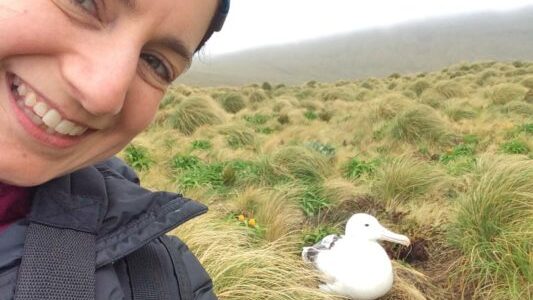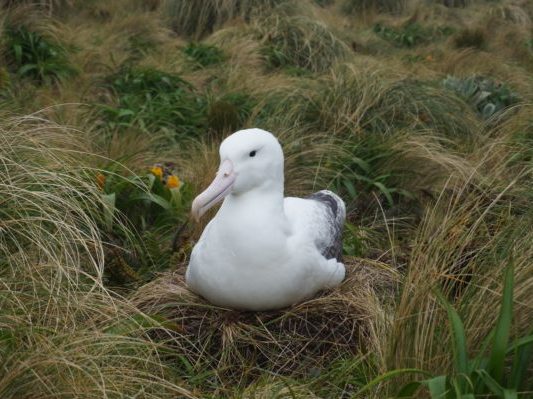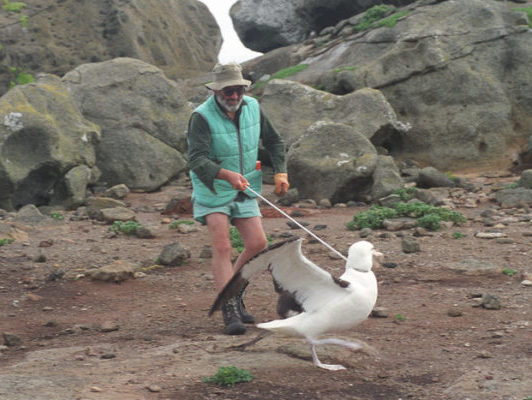New Zealand is the albatross capital of the world, with more than a dozen varieties. So where do they all live and why are so many of them classed as vulnerable?

It can be difficult to imagine how big an albatross is until you’re standing next to one.
The Southern Royal albatrosses were nesting when I visited Campbell Island, one of New Zealand’s remote subantarctic islands, in mid-December with Heritage Expeditions. These days Campbell is uninhabited and human visitors are rare, yet the albatrosses were unfazed by our presence at the top of the rugged and windy Col Lyle Boardwalk, surrounded by regenerating tussock and burgeoning megaherbs.
A few of them soared above us in the grey sky, their wings slicing effortlessly through the cold air. New Zealand’s largest seabirds, graceful and glorious.
Life at sea

Apart from their remarkable size, which includes a wingspan of up to 3.7 metres, albatrosses have many other special qualities. They spend an estimated 85% of their lives at sea, using the powerful ocean winds to carry them thousands of kilometres with minimal exertion. When they finally return to land at around 5-6 years old to nest, there are some rough landings and they often struggle to walk for the first couple of days as they adjust to terra firma.
Albatrosses have been known to live for more than 60 years, but certain factors make them vulnerable. During their time at sea they’re at risk from long-line and net fishing, as well as plastic-filled waters in the northern hemisphere. A violent storm can wipe out a nesting site for years and cause untold knock-on effects such as the laying of thin-shelled eggs, which is caused by stressful nesting conditions.
They also take a long time to begin breeding – up to 14 years, in the case of the Wandering albatross – with widely-spaced breeding cycles and low reproduction rates: every 2-3 years an albatross lays on average just one precious egg, which involves about 70-80 days of incubation and then 140-170 (but up to 280, depending on the species) days of tending to their fledgling chick. If the egg is broken or stolen, it’s all over for the year.
Best mates
Albatrosses are very faithful partners: they form breeding pairs and mate for life. Their homing instinct is keen and they usually return to their place of origin to nest, often just a few dozen metres from where they were hatched.
To refine their courtship skills while on land, the great albatrosses also perform a ‘gamming’ display by facing one another, extending their large wings, dancing from side to side, raising their beaks to the sky and making small yelps and yapping sounds. ‘Gamming’ is an old sailing term, referring to the pre-Facebook practice of two whaling ships coming together at sea to exchange news.
Professional boundaries
But beware of tossing around words that humanise animal behaviour, warns Dr Chris Robertson, an ornithologist from Wellington who has been studying rare NZ birds for decades. One of his earliest bird-related memories is the thrill of a rare Australasian Coot sighting while visiting Lake Tūtira in the early 1950s with his father, who was a keen bird-watcher.
As part of his day job (over the years he has worked for NZ Wildlife Service, then with DOC, and in 2008 was awarded the Queen’s Service Medal for services to ornithology), Robertson has balanced on the precipices some of our wildest, most inhospitable offshore islands to observe rare albatrosses. However, despite his long-term relationship with them he baulks at the idea of favourite species or cute nicknames: no Jane Goodall-esque ‘Greybeard’ (or in this case, no ‘Sooty’ or ‘Pinkbeak’).
“I get very unhappy about that because it creates confusion. When you’ve got hundreds of birds to keep track of you can’t have names for all of them, and it’s dangerous to get emotional.”
Instead, coloured bands are used as identifiers so an individual can be referred to, for example, as “Yellow-Orange” (with “YO” being an acceptable abbreviation).
Crunching the numbers
There are about 24 varieties or taxa of albatrosses worldwide, most of which can be found near or on New Zealand’s remote offshore islands. But the exact number of taxa has been hotly debated over the years and Robertson argues that media and conservation groups often lump several taxa into what he calls the “corporate albatross” for simplicity’s sake.
New Zealand boasts more albatross species than anywhere else in the world. Our unique albatross taxa or groups include:
• Antipodean (wandering) albatross
• Gibson’s (wandering) albatross
• Northern and Southern Royal albatross (also known as the ‘Greats’; the biggest ones)
• White-Capped albatross
• Indian Yellow-Nosed albatross
• Chatham Island albatross
• Campbell Island mollymawk (a mollymawk is a small-to-medium-sized NZ albatross)
• Grey-Headed mollymawk
• Salvin’s mollymawk
• Northern and Southern Buller’s mollymawk
• Light-Mantled Sooty albatross
Of all the albatross taxa worldwide, three are considered by the IUCN (International Union for Conservation of Nature) to be Critically Endangered, including the Chatham Islands albatross, and five are considered Endangered. All but two are considered to be vulnerable.
But conservationists sometimes have a habit of focussing on the short-term data, Robertson believes, and almost half a century of research has provided him with a broader perspective.
“Some albatross populations are clearly not comfortable. But look at all of the groups alongside one another: some are just starting out, some are at their peak, and some are declining and will one day disappear. Various things will affect that over time, including introduced predators, climatic events, and human behaviour.”
Extrapolating knee-jerk, “trigger figures” from a small sample can also be risky and misleading, says Robertson.
“There’s a tendency to get excited and jump to conclusions. It’s normal for populations to fluctuate [naturally] over a period of time.”
Controlling the predators
We may not be able to manipulate time, but we can control some things. In the stormy sub-antarctic, for example, Enderby Island has been returned to its former predator-free state thanks to the complete removal of introduced animals such as rabbits, cattle and sheep. Adams Island and The Snares have always been predator-free.
Albatross numbers on Campbell Island dramatically improved after the eradication of sheep and rats (although Robertson comments that it will be interesting to see the effect on nesting albatrosses of the regenerating scrub such as the dracophyllum, which was burned off during the 19th- and early 20th-century farming attempts on Campbell and Enderby Islands).
Meanwhile, on Auckland Island (the largest of the sub-antarctic islands at 443m2), the remaining wild pigs are still a threat to the nesting grounds of White-Capped and Wandering albatrosses. DOC has announced plans to remove the pigs and in May 2017 began recruiting for ‘project planners’ to help with the eradication.
On the New Zealand mainland there is a stable Northern Royal albatross colony at Taiaroa Head in Otago (there is a live webcam), but that hasn’t always been the case. The first major threat in the area was humans, who hunted the albatross for its eggs, then came the wild dogs, cats and ferrets. These days zealous trapping is still required to control the local stoats, which zoom in to snatch any exposed eggs.
But the Taiaroa Head albatrosses are also troubled by a much smaller, deadlier predator: the blowfly. Imported in the 1980s along with merino sheep from Central Otago, the miniature menaces hatch young maggots inside the slow-hatching albatross eggs. A somewhat effective solution has been adding peppermint to the nests because the scent deters the flies. Planting Pyrethrum daisies has helped for the same reason, and, most successfully, hatching the eggs in incubators.
Extreme bird-watching
Advances in technology have played a part in helping to protect albatrosses and other rare birds. But DNA research, while certainly validating several of Roberton’s earlier, tricky-to-prove claims about distinct albatross taxa, is not enough in itself, he argues, and nor are satellite-based observations of bird colonies from space.
“That’s very limiting. You don’t know what’s happening on the ground and you’re taking shortcuts, usually to save money. You need that time on the land and at sea to really get the full picture.”
Robertson has spent much of his life researching the physiology and behaviour of rare birds, often from hair-raising vantage points. Because albatrosses often favour steep clifftop locations for nesting, on isolated islands surrounded by wild, inhospitable seas, this has made for some logistically challenging and uncomfortable workdays.

“The islands also have seals that don’t take kindly to you walking through their patch. We had shepherd’s crooks and sometimes had to use them to bonk the seals firmly on the nose.”
Many albatrosses, including Northern Royals, nest on the smaller, uninhabited Chatham Islands – such as the Sisters and Forty-Fours – and Robertson frequently had to battle seasickness and lug heavy equipment and supplies, including a month’s worth of drinking water to last the visit, up steep cliffs to get there. He once camped on a “particularly inhospitable” precarious, downward-facing slope on the tiny Pyramid Island to observe Chatham Island albatrosses; another time he was forced to share a tiny pup tent with another scientist on the Pyramid for 11 days. To pass the time, he says, “there was a lot of discussion about albatross taxonomy”.
It wasn’t unusual to lose equipment and Robertson also had some near-misses of his own.
“I used to carry all my cameras in big tupperware containers to keep them dry. We didn’t wear life-jackets then, so whenever I fell out of the dinghy I was relying on my tupperware box to keep me afloat. In the 1990s I almost got polished off when we tried to land on the Forty-Fours. We were late in the day getting there – that’s always a mistake – the wind had picked up, I had to climb over slippery bull kelp on the rocks and I fell into the water. The top popped off the tupperware box, so I was slowly sinking and I was also getting swept into a gulch. One man jumped in to save me, but he landed on top of me! By the time we finally got back to the island, 95% of our gear had been washed away.”
Natural forces
Each taxa is unique, with its own physical and behavioural traits. A Wandering albatross, for example, often has to travel long distances on feeding trips which makes it more vulnerable to natural events that affect its breeding cycle.
A dramatic cyclone in the 1980s threatened the Buller’s and Northern Royal albatrosses on the Forty-Fours. It destroyed their vegetation and they had to pack more tightly together in viable areas, causing thin-shelled eggs that were prone to breakage. The dry conditions also resulted in what Robertson calls “gladwrap eggs”, with a thin membrane inside them which had dried out and trapped the hatching chicks. Breeding success dropped to almost zero.
But while one ecologist predicted the recovery to take 300 years, it has taken just 30 for the islands’ vegetation and chick populations to bounce back, mostly thanks to the “natural fertiliser” of albatross poo.
“Sometimes nature is wiser than we are. Humans can’t fix everything,” says Robertson.
Human threats
Albatrosses live to be 35-40 years old on average, and can even make it to over 60. But their time can often be cut short by plastic-polluted waters (in the northern hemisphere) and overfishing, as well as long-line and net fishing. Robertson’s autopsies on dead albatrosses revealed from their stomach contents that they swoop down on fishing boats to steal the offal discharged from the fish factories on board, which probably seems like a fast-food win, but they risk getting hooked by the beak or wing, hit by trawl wires, or trapped in nets being hauled from the deep.
A memorable presentation by Robertson to the NZ Seafood Industry Council in 2005, when he took along an array of birds’ heads to show the damage from fishing practices, caused a ripple effect of widespread changes to the industry. These days heavier hooks are used to weigh down the bait, which has substantially reduced the death toll from longlining. With better processing of the fish itself, much less ‘tempting’ offal is being discharged as well.
“The industry has been good at listening, and the problem can be significantly reduced as long as certain practises are followed. But you’re never going to get a zero bycatch. Unless fishing stops completely, there will always be a reason for a bird to get stuck.”

